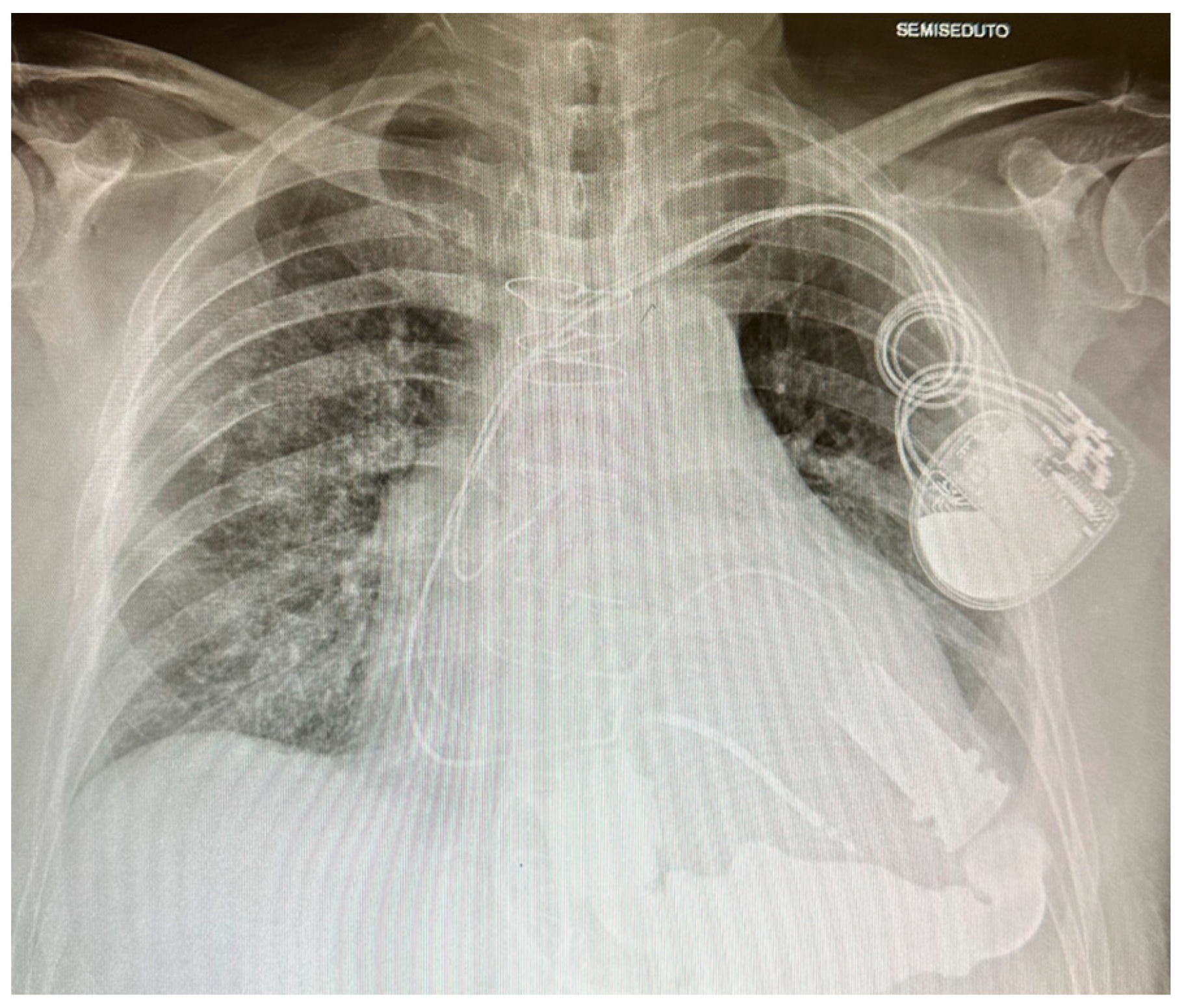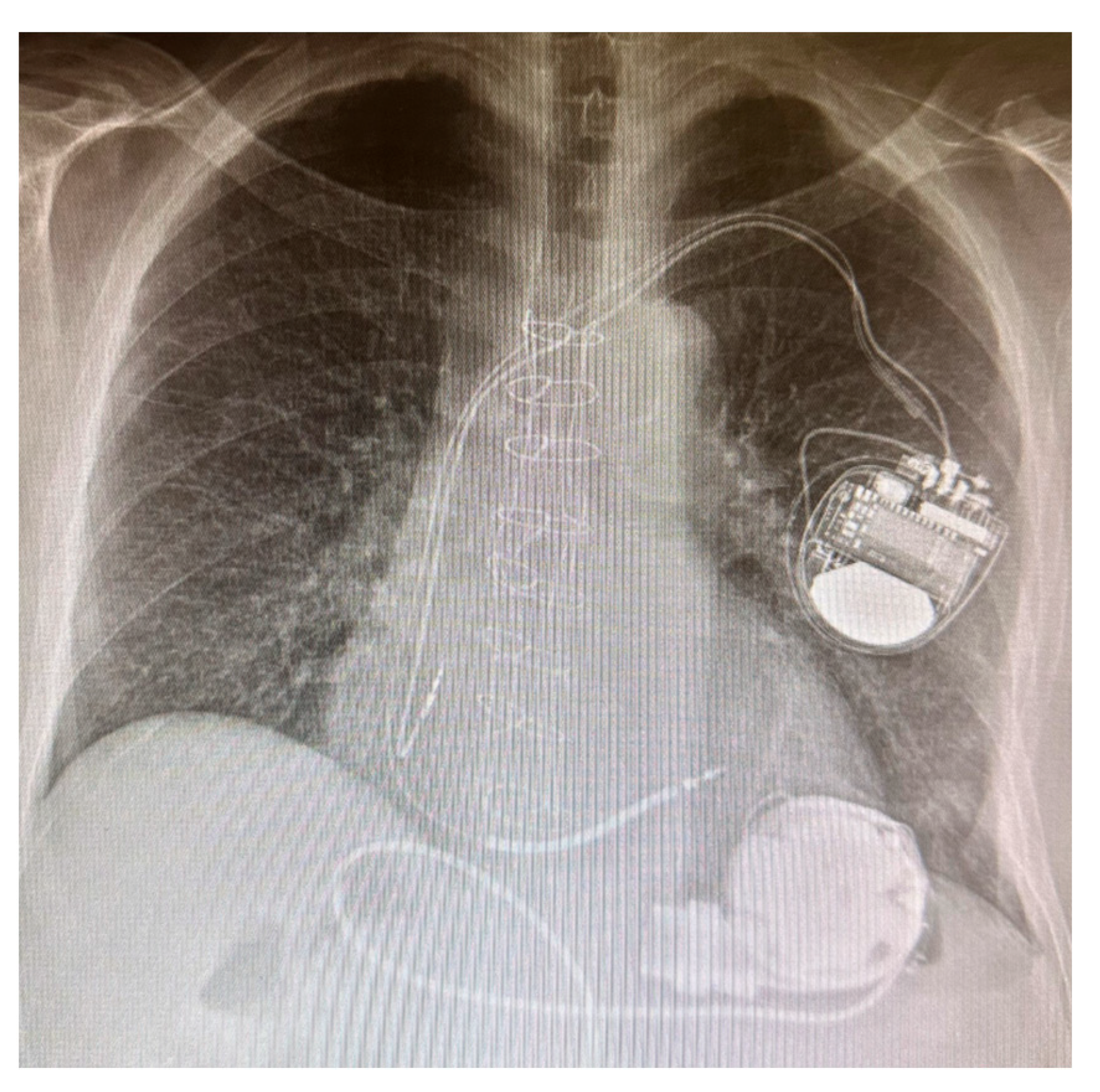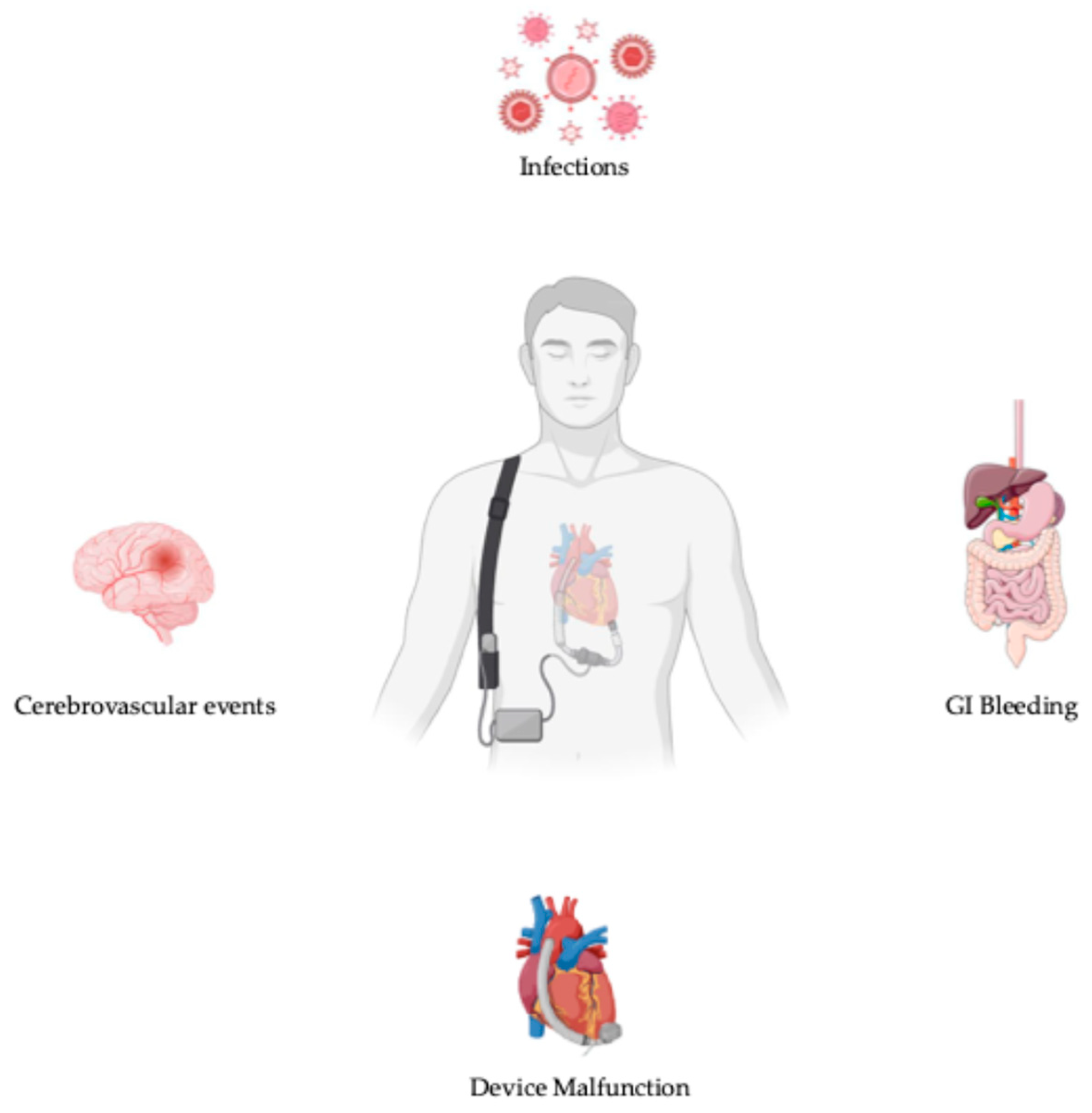Outcome Through the Years of Left-Ventricular Assist Devices Therapy for End-Stage Heart Failure: A Review
Abstract
1. Introduction
2. End-Stage Heart Failure: When Medical Therapy Is Not Enough
3. LVAD: A Machine to Supplement the Heart
4. Evolution in Mechanical Circulatory Support: From Axial to Centrifugal Flow Pumps
5. Outcome of Patients with an LVAD
5.1. Cerebrovascular Events
5.2. Gastro-Intestinal Bleeding
5.3. Infections in Patients with LVADs
6. Conclusions: Looking at the Future, What Is Next?
Author Contributions
Funding
Institutional Review Board Statement
Informed Consent Statement
Data Availability Statement
Conflicts of Interest
References
- Heidenreich, P.A.; Bozkurt, B.; Aguilar, D.; Allen, L.A.; Byun, J.J.; Colvin, M.M.; Deswal, A.; Drazner, M.H.; Dunlay, S.M.; Evers LRFang, J.C. 2022 AHA/ACC/HFSA Guideline for the Management of Heart Failure: A Report of the American College of Cardiology/American Heart Association Joint Committee on Clinical Practice Guidelines. J. Am. Coll. Cardiol. 2022, 79, e263–e421. [Google Scholar] [PubMed]
- Kirklin, J.K.; Naftel, D.C.; Pagani, F.D.; Kormos, R.L.; Stevenson, L.W.; Blume, E.D.; Myers, S.L.; Miller, M.A.; Baldwin, J.T.; Young, J.B. Seventh INTERMACS annual report: 15,000 patients and counting. J. Heart Lung Transplant. 2015, 34, 1495–1504. [Google Scholar] [CrossRef] [PubMed]
- McDonagh, T.A.; Metra, M.; Adamo, M.; Gardner, R.S.; Baumbach, A.; Böhm, M.; Burri, H.; Butler, J.; Čelutkienė, J.; Chioncel, O.; et al. 2021 ESC Guidelines for the diagnosis and treatment of acute and chronic heart failure. Eur. Heart J. 2021, 42, 3599–3726. [Google Scholar] [CrossRef] [PubMed]
- Hanff, T.C.; Birati, E.Y. Left Ventricular Assist Device as Destination Therapy: A State of the Science and Art of Long-Term Mechanical Circulatory Support. Curr. Heart Fail. Rep. 2019, 16, 168–179. [Google Scholar] [CrossRef]
- Kadakia, S.; Moore, R.; Ambur, V.; Toyoda, Y. Current status of the implantable LVAD. Gen. Thorac. Cardiovasc. Surg. 2016, 64, 501–508. [Google Scholar] [CrossRef]
- Mehra, M.R.; Canter, C.E.; Hannan, M.M.; Semigran, M.J.; Uber, P.A.; Baran, D.A.; Danziger-Isakov, L.; Kirklin, J.K.; Kirkm, R.; Kushwaha, S.S.; et al. The 2016 International Society for Heart Lung Transplantation listing criteria for heart transplantation: A 10-year update. J. Heart Lung Transplant. 2016, 35, 1–23. [Google Scholar] [CrossRef]
- Truby, L.K.; Rogers, J.G. Advanced Heart Failure. JACC Heart Fail. 2020, 8, 523–536. [Google Scholar] [CrossRef]
- DeBakey, M.E. Left ventricular bypass pump for cardiac assistance. Am. J. Cardiol. 1971, 27, 384–389. [Google Scholar] [CrossRef]
- Norman, J.C. ALVAD 1979: Precedence, potentials, prospects and problems. Cardiovasc. Dis. 1979, 6, 384–389. [Google Scholar]
- Hunt, S. The REMATCH Trial: Long-term Use of a Left Ventricular Assist Device for End-Stage Heart Failure. J. Card. Fail. 2002, 8, 59–60. [Google Scholar] [CrossRef]
- Rose, E.A.; Gelijns, A.C.; Moskowitz, A.J.; Heitjan, D.F.; Stevenson, L.W.; Dembitsky, W.; Long, J.W.; Ascheim, D.D.; Tierney, A.R.; Levitan, R.G. Long-term use of a left ventricular assist device for end-stage heart failure. N. Engl. J. Med. 2001, 345, 1435–1443. [Google Scholar] [CrossRef] [PubMed]
- Chair, S.Y.; Yu, D.S.F.; Ng, M.T.; Wang, Q.; Cheng, H.Y.; Wong, E.M.L.; Sit, J.W. Evolvement of left ventricular assist device: The implications on heart failure management. J. Geriatr. Cardiol. 2016, 13, 425–430. [Google Scholar] [PubMed]
- Berardi, C.; Bravo, C.A.; Li, S.; Khorsandi, M.; Keenan, J.E.; Auld, J.; Rockom SBeckman, J.A.; Mahr, C. The History of Durable Left Ventricular Assist Devices and Comparison of Outcomes: HeartWare, HeartMate II, HeartMate 3, and the Future of Mechanical Circulatory Support. J. Clin. Med. 2022, 11, 2022. [Google Scholar] [CrossRef] [PubMed]
- Recalls Related to HVAD System. Available online: https://www.fda.gov/medical-devices/cardiovascular-devices/recalls-related-hvad-system (accessed on 3 June 2021).
- Long, J.W.; Kfoury, A.G.; Slaughter, M.S.; Silver, M.; Milano, C.; Rogers j Delgado, R.; Frazier, O.H. Long-Term Destination Therapy with the HeartMate XVE Left Ventricular Assist Device: Improved Outcomes Since the REMATCH Study. Congest. Heart Fail. 2005, 11, 133–138. [Google Scholar] [CrossRef]
- Slaughter, M.S.; Rogers, J.G.; Milano, C.A.; Russel, S.D.; Conte, J.V.; Feldman, D.; Sun, B.; Tatooles AJDelgado, R.M., 3rd; Long, J.W.; Frazier, O.H.; et al. Advanced heart failure treated with continuous-flow left ventricular assist device. N. Engl. J. Med. 2009, 361, 2241–2251. [Google Scholar] [CrossRef]
- Starling, R.C.; Moazami, N.; Silvestry, S.C.; Ewald, G.; Rogers, J.G.; Milano, C.A.; Rame, J.E.; Acker, M.A.; Blackstone, E.H.; Ehrlinger, J.; et al. Unexpected abrupt increase in left ventricular assist device thrombosis. N. Engl. J. Med. 2014, 370, 33–40. [Google Scholar] [CrossRef]
- Levine, A.; Gass, A. Third-Generation LVADs Has Anything Changed? Cardiol. Rev. 2019, 27, 293–301. [Google Scholar] [CrossRef]
- Aaronson, K.D.; Slaughter, M.S.; Miller, L.W.; McGee, E.; Cotts, W.G.; Acker, M.A.; Jessup, M.L.; Gregoric, I.D.; Loyalka, P.; Frazier, O.H.; et al. Use of an Intrapericardial, Continuous-Flow, Centrifugal Pump in Patients Awaiting Heart Transplantation. Circulation 2012, 125, 3191–3200. [Google Scholar] [CrossRef]
- Rogers, J.G.; Pagani, F.D.; Tatooles, A.J.; Bhat, G.; Slaughter, M.S.; Birks, E.J.; Boyce, S.W.; Najjar, S.S.; Jeevanandam, V.; Anderson, A.S.; et al. Intrapericardial Left Ventricular Assist Device for Advanced Heart Failure. N. Engl. J. Med. 2017, 376, 451–460. [Google Scholar] [CrossRef]
- Milano, C.A.; Rogers, J.G.; Tatooles, A.J.; Bhat, G.; Slaughter, M.S.; Birks, E.J.; Mokadam, N.A.; Mahr, C.; Miller, J.S.; Markham, D.W.; et al. ENDURANCE Investigators. HVAD: The ENDURANCE Supplemental Trial. J. Am. Coll. Cardiol. 2018, 6, 792–802. [Google Scholar]
- Mehra, M.R.; Naka, Y.; Uriel, N.; Goldstein, D.J.; Cleveland jr, J.C.; Colombo, P.C.; Walsh, M.N.; Milano, C.A.; Patel, C.B.; Jorde, U.P.; et al. A Fully Magnetically Levitated Circulatory Pump for Advanced Heart Failure. N. Engl. J. Med. 2017, 376, 440–450. [Google Scholar] [CrossRef] [PubMed]
- Mehra, M.R.; Uriel, N.; Naka, Y.; Cleveland jr, J.C.; Yuzefpolskaya, M.; Salerno, C.T.; Walsh, M.N.; Milano, C.A.; Patel, C.B.; Hutchins, S.W.; et al. A Fully Magnetically Levitated Left Ventricular Assist Device—Final Report. N. Engl. J. Med. 2019, 380, 1618–1627. [Google Scholar] [CrossRef] [PubMed]
- Guglin, M.; Zucker, M.J.; Borlaug, B.A.; Breen, E.; Cleveland, J.; Johnson, M.R.; Panjrath, G.S.; Patel, J.K.; Starling, R.C.; Bozkurt, B.; et al. Evaluation for Heart Transplantation and LVAD Implantation JACC Council Perspectives. J. Am. Coll. Cardiol. 2020, 75, 1471–1487. [Google Scholar] [CrossRef] [PubMed]
- Theochari, C.A.; Michalopoulos, G.; Oikonomou, E.K.; Giannopoulos, S.; Doulamis, I.P.; Alvarez Villela, M.; Kokkinidis, D.G. Heart transplantation versus left ventricular assist devices as destination therapy or bridge to transplantation for 1-year mortality: A systematic review and meta-analysis. Ann. Cardiothorac. Surg. 2018, 7, 3. [Google Scholar] [CrossRef]
- Schmitto, J.D.; Shaw, S.; Garbade, J.; Gustaffson, F.; Morshuis, M.; Zimpfer, D.; Lavee, J.; Pya, Y.; Berchtold-Herz, M.; Wang, A.; et al. Fully magnetically centrifugal left ventricular assist device and long-term outcomes: The ELEVATE registry. Eur. Heart J. 2024, 45, 613–625. [Google Scholar] [CrossRef]
- Caraballo, C.; De Filippis, E.M.; Nakagawa, S.; Ravindra, N.G.; Miller, P.E.; Mezzacappa, C.; McCullough, M.; Gruen, J.; Levin, A.; Reinhardt, S.; et al. Clinical Outcomes After Left Ventricular Assist Device Implantation in Older Adults: An INTERMACS Analysis. JACC Heart Fail. 2019, 7, 1069–1078. [Google Scholar] [CrossRef]
- Emerson, D.; Chikwe, J.; Catarino, P.; Hassanein, M.; Deng, L.; Cantor, R.S.; Roach, A.; Cole, R.; Esmailian, F.; Kobashigawa, J.; et al. Contemporary Left Ventricular Assist Device Outcomes in an Aging Population: An STS INTERMACS Analysis. J. Am. Coll. Cardiol. 2021, 78, 883–894. [Google Scholar] [CrossRef]
- Jorde, U.P.; Saeed, O.; Koehl, D.; Morris, A.A.; Wood, K.L.; Meyer, D.M.; Cantor, R.; Jacobs, J.P.; Kirklin, J.K.; Pagani, F.D.; et al. The Society of Thoracic Surgeons Intermacs 2023 Annual Report: Focus on Magnetically Levitated Devices. Ann. Thorac. Surg. 2024, 117, 33–44. [Google Scholar] [CrossRef]
- Kirklin, J.K.; Pagani, F.D.; Kormos, R.L.; Stevenson, L.W.; Blume, E.D.; Myers, S.L.; Miller, M.A.; Baldwin, J.T.; Young, J.B.; Naftel, D.C. Eighth annual INTERMACS report: Special focus on framing the impact of adverse events. J. Heart Lung Transplant. 2017, 36, 1080–1086. [Google Scholar] [CrossRef]
- Miller, L.W.; Rogers, J.G. Evolution of Left Ventricular Assist Device Therapy for Advanced Heart Failure: A Review. JAMA Cardiol. 2018, 3, 650–658. [Google Scholar] [CrossRef]
- Inamullah, O.; Chiang, Y.P.; Bishawi, M.; Weiss, M.; Lutz, M.W.; Blue, L.J.; Feng, W.; Milano, C.A.; Luedke, M.; Husseini, N.E. Characteristics of strokes associated with centrifugal flow left ventricular assist devices. Sci. Rep. 2021, 11, 1645. [Google Scholar] [CrossRef] [PubMed]
- Kadakkal, A.; Najjar, S.S. Neurologic Events in Continuous-Flow Left Ventricular Assist Devices. Cardiol. Clin. 2018, 36, 531–539. [Google Scholar] [CrossRef] [PubMed]
- Kirklin, J.K.; Naftel, D.C.; Myers, S.L.; Pagani, F.D.; Colombo, P.C. Quantifying the impact from stroke during support with continuous flow ventricular assist devices: An STS INTERMACS analysis. J. Heart Lung Transplant. 2020, 39, 782–794. [Google Scholar] [CrossRef] [PubMed]
- Varshney, A.S.; De Filippis, E.M.; Cowger, J.A.; Netuka, I.; Pinney, S.P.; Givertz, M.M. Trends and Outcomes of Left Ventricular Assist Device Therapy: JACC Focus Seminar. J. Am. Coll. Cardiol. 2022, 79, 1092–1107. [Google Scholar] [CrossRef]
- Cushing, K.; Kushnir, V. Gastrointestinal Bleeding Following LVAD Placement from Top to Bottom. Dig. Dis. Sci. 2016, 61, 1440–1447. [Google Scholar] [CrossRef]
- Hammer, Y.; Xie, J.; Yang, G.; Bitar, A.; Haft, J.W.; Cascino, T.M.; Likosky, D.S.; Pagani, F.D.; Zhang, M.; Aaronson, K.D. Gastrointestinal bleeding following Heartmate 3 left ventricular assist device implantation: The Michigan Bleeding Risk Model. J. Heart Lung Transplant. 2024, 43, 604–614. [Google Scholar] [CrossRef]
- Hallett, A.M.; Guo, Y.; Grossi, E.A.; Balsam, L.B. Gastrointestinal Bleeding after Continuous Flow Left Ventricular Assist Device Implantation: Analysis of the INTERMACS Registry. J. Am. Coll. Surg. 2017, 225, S29–S30. [Google Scholar] [CrossRef]
- Hannan, M.M.; Husain, S.; Mattner, F.; Danziger-Isakov, L.; Drew, R.J.; Corey, G.R.; Schueler, S.; Holman, W.L.; Lawler, L.P.; Gordon, S.M.; et al. Working formulation for the standardization of definitions of infections in patients using ventricular assist devices. J. Heart Lung Transplant. 2011, 30, 375–384. [Google Scholar] [CrossRef]
- Qu, Y.; Peleg, A.Y.; McGiffin, D. Ventricular Assist Device-Specific Infections. J. Clin. Med. 2021, 10, 453. [Google Scholar] [CrossRef]
- Kusne, S.; Mooney, M.; Danziker-Isakov, L.; Kaan, A.; Lund, L.H.; Lyster, H.; Wieselthaler, G.; Aslam, S.; Cagliostro, B.; Chen, J.; et al. An ISHLT consensus document for prevention and management strategies for mechanical circulatory support infection. J. Heart Lung Transplant. 2017, 36, 1137–1153. [Google Scholar] [CrossRef]
- Koval, C.E.; Thuita, L.; Moazami, N.; Blackstone, E. Evolution and impact of drive-line infection in a large cohort of continuous-flow ventricular assist device recipients. J. Heart Lung Transplant. 2014, 33, 1164–1172. [Google Scholar] [CrossRef] [PubMed]
- Bernhardth, A.M.; Schloglhofer, T.; Lauenroth, V.; Mueller, F.; Mueller, M.; Schoede, A.; Klopch, C. Prevention and early treatment of driveline infections in ventricular assist device patients—The DESTINE staging proposal and the first standard of care protocol. J. Crit. Care 2020, 56, 106–112. [Google Scholar] [CrossRef] [PubMed]
- Dual, S.A.; Cowger, J.; Roche, E.; Nayak, A. The Future of Durable Mechanical Circulatory Support: Emerging Technological Innovations and Considerations to Enable Evolution of the Field. J. Card. Fail. 2024, 330, 596–609. [Google Scholar] [CrossRef] [PubMed]
- Mehra, M.; Castagna, F.; Butler, J. The transformative potential of left ventricular assist devices in advanced heart failure: No more a therapeutic orphan. Eur. Heart J. 2024, 45, 626–628. [Google Scholar] [CrossRef]



| BTD (Bridge to Decision) BTB (Bridge to Bridge) | Short-Term MCS in patients with drug-refractory cardiogenic shock at immediate risk of death to sustain life until a clinical evaluation is completed |
| BTC (Bridge to Candidacy) | Long-Term MCS to improve end-organ function and to make a patient eligible for HT |
| BTT (Bridge to Transplant) | Long-Term MCS to keep alive a patient at high risk of death until an organ donor becomes available |
| BTR (Bridge to Recovery) | Long-Term-Short-Term MCS to keep a patient alive until the cardiac function recovers sufficiently to remove MCS |
| DT (Destination Therapy) | Long-Term MCS in those patients with end-stage heart failure ineligible for HT |
Disclaimer/Publisher’s Note: The statements, opinions and data contained in all publications are solely those of the individual author(s) and contributor(s) and not of MDPI and/or the editor(s). MDPI and/or the editor(s) disclaim responsibility for any injury to people or property resulting from any ideas, methods, instructions or products referred to in the content. |
© 2024 by the authors. Licensee MDPI, Basel, Switzerland. This article is an open access article distributed under the terms and conditions of the Creative Commons Attribution (CC BY) license (https://creativecommons.org/licenses/by/4.0/).
Share and Cite
Tropea, I.; Cresce, G.D.; Sanesi, V.; Salvador, L.; Zoni, D. Outcome Through the Years of Left-Ventricular Assist Devices Therapy for End-Stage Heart Failure: A Review. J. Clin. Med. 2024, 13, 6622. https://doi.org/10.3390/jcm13216622
Tropea I, Cresce GD, Sanesi V, Salvador L, Zoni D. Outcome Through the Years of Left-Ventricular Assist Devices Therapy for End-Stage Heart Failure: A Review. Journal of Clinical Medicine. 2024; 13(21):6622. https://doi.org/10.3390/jcm13216622
Chicago/Turabian StyleTropea, Ilaria, Giovanni Domenico Cresce, Valerio Sanesi, Loris Salvador, and Daniele Zoni. 2024. "Outcome Through the Years of Left-Ventricular Assist Devices Therapy for End-Stage Heart Failure: A Review" Journal of Clinical Medicine 13, no. 21: 6622. https://doi.org/10.3390/jcm13216622
APA StyleTropea, I., Cresce, G. D., Sanesi, V., Salvador, L., & Zoni, D. (2024). Outcome Through the Years of Left-Ventricular Assist Devices Therapy for End-Stage Heart Failure: A Review. Journal of Clinical Medicine, 13(21), 6622. https://doi.org/10.3390/jcm13216622






